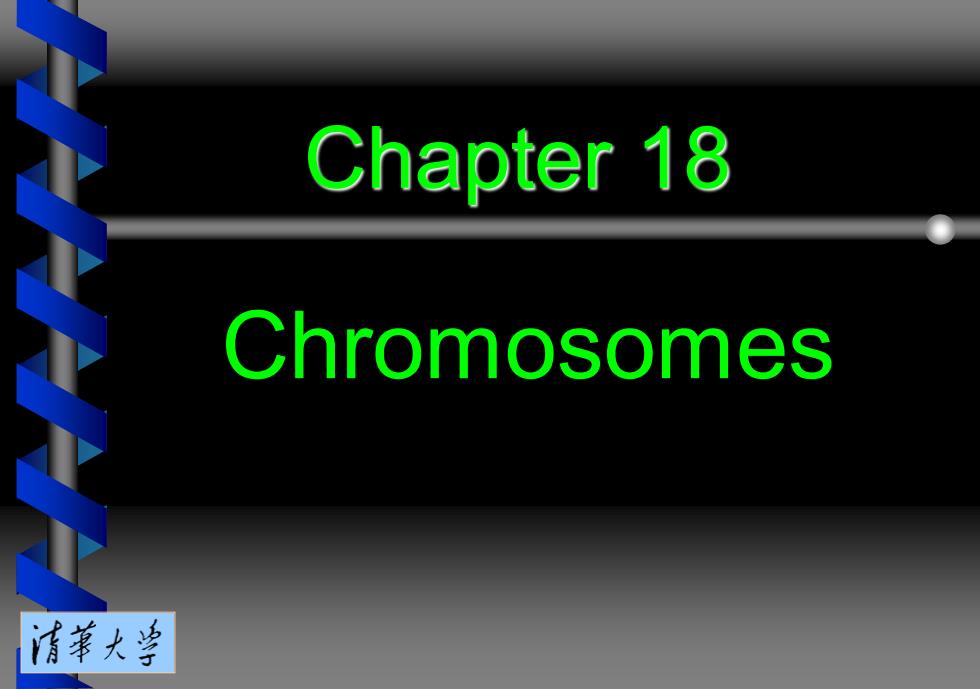
Chapter 18 Chromosomes 清革大当
Chapter 18 Chromosomes
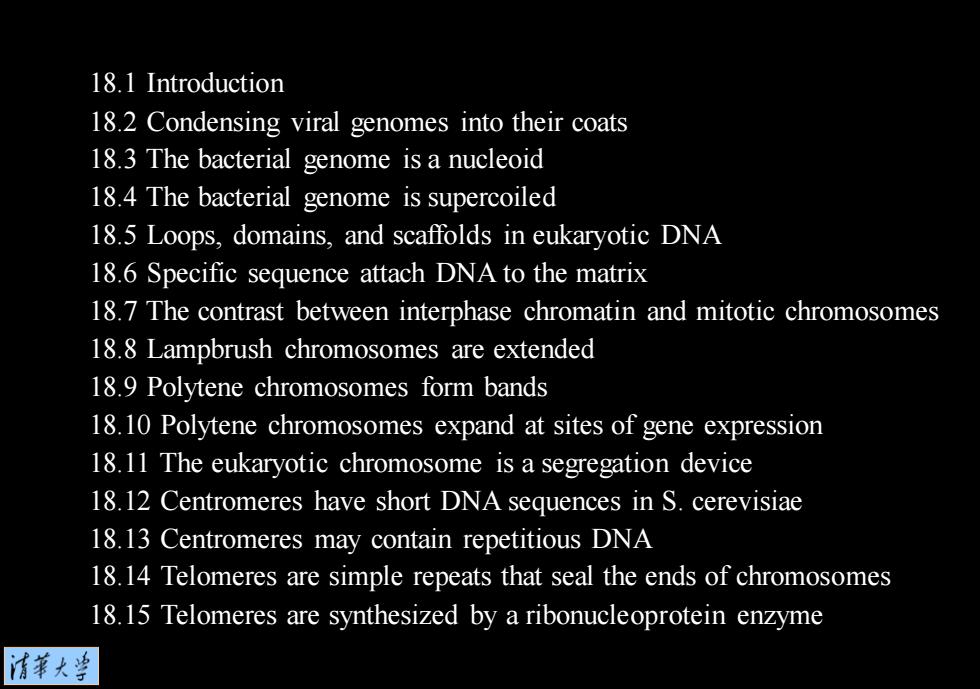
18.1 Introduction 18.2 Condensing viral genomes into their coats 18.3 The bacterial genome is a nucleoid 18.4 The bacterial genome is supercoiled 18.5 Loops,domains,and scaffolds in eukaryotic DNA 18.6 Specific sequence attach DNA to the matrix 18.7 The contrast between interphase chromatin and mitotic chromosomes 18.8 Lampbrush chromosomes are extended 18.9 Polytene chromosomes form bands 18.10 Polytene chromosomes expand at sites of gene expression 18.11 The eukaryotic chromosome is a segregation device 18.12 Centromeres have short DNA sequences in S.cerevisiae 18.13 Centromeres may contain repetitious DNA 18.14 Telomeres are simple repeats that seal the ends of chromosomes 18.15 Telomeres are synthesized by a ribonucleoprotein enzyme 情菜大兰
18.1 Introduction 18.2 Condensing viral genomes into their coats 18.3 The bacterial genome is a nucleoid 18.4 The bacterial genome is supercoiled 18.5 Loops, domains, and scaffolds in eukaryotic DNA 18.6 Specific sequence attach DNA to the matrix 18.7 The contrast between interphase chromatin and mitotic chromosomes 18.8 Lampbrush chromosomes are extended 18.9 Polytene chromosomes form bands 18.10 Polytene chromosomes expand at sites of gene expression 18.11 The eukaryotic chromosome is a segregation device 18.12 Centromeres have short DNA sequences in S. cerevisiae 18.13 Centromeres may contain repetitious DNA 18.14 Telomeres are simple repeats that seal the ends of chromosomes 18.15 Telomeres are synthesized by a ribonucleoprotein enzyme
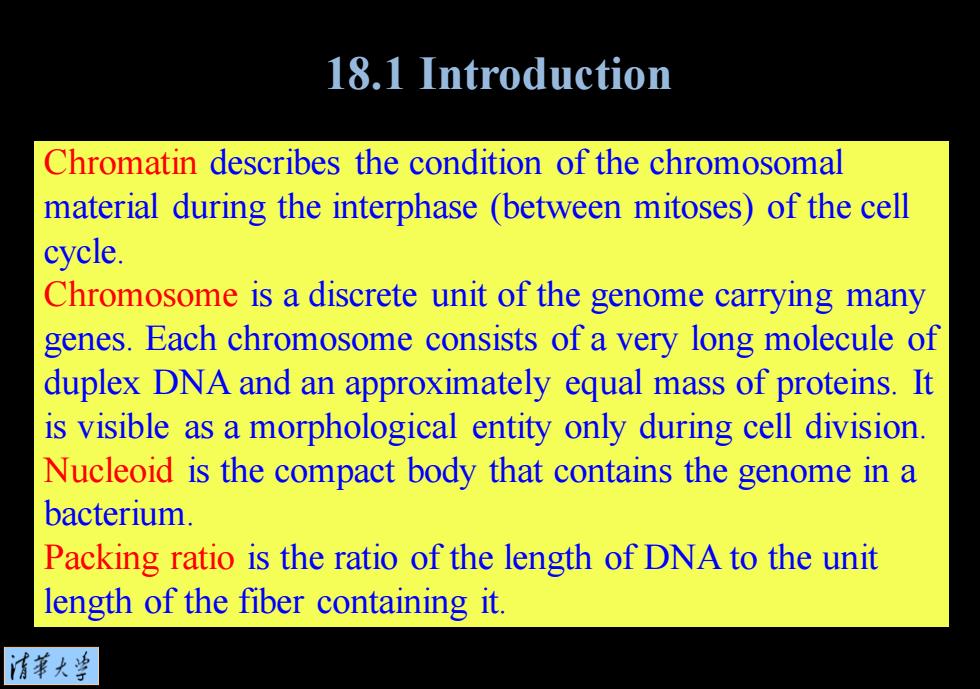
18.1 Introduction Chromatin describes the condition of the chromosomal material during the interphase (between mitoses)of the cell cycle. Chromosome is a discrete unit of the genome carrying many genes.Each chromosome consists of a very long molecule of duplex DNA and an approximately equal mass of proteins.It is visible as a morphological entity only during cell division. Nucleoid is the compact body that contains the genome in a bacterium. Packing ratio is the ratio of the length of DNA to the unit length of the fiber containing it. 清菜大当
Chromatin describes the condition of the chromosomal material during the interphase (between mitoses) of the cell cycle. Chromosome is a discrete unit of the genome carrying many genes. Each chromosome consists of a very long molecule of duplex DNA and an approximately equal mass of proteins. It is visible as a morphological entity only during cell division. Nucleoid is the compact body that contains the genome in a bacterium. Packing ratio is the ratio of the length of DNA to the unit length of the fiber containing it. 18.1 Introduction
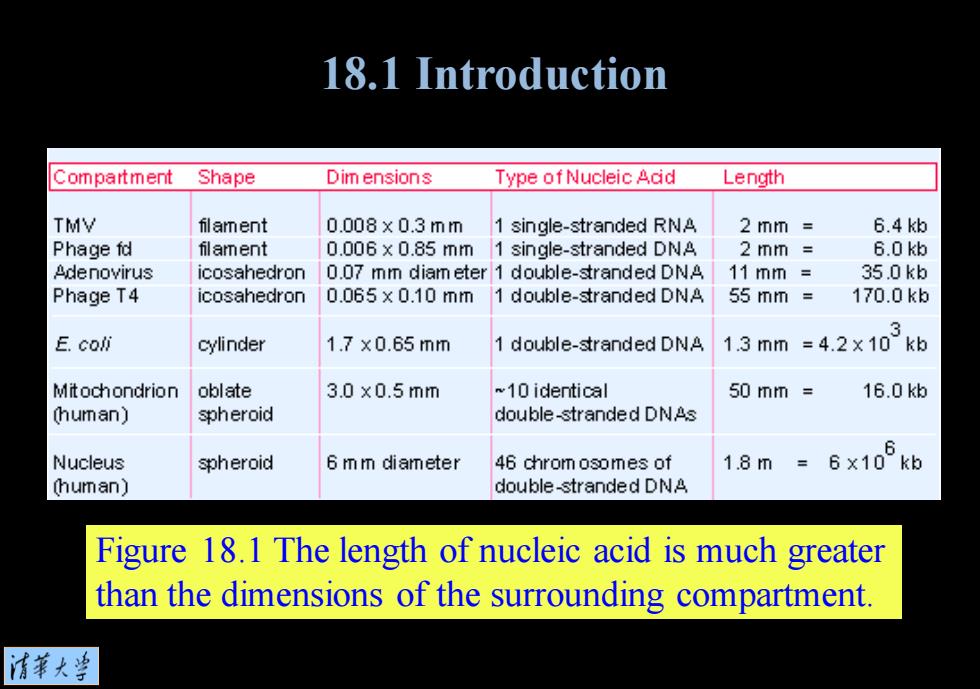
18.1 Introduction Compartment Shape Dim ensions Type of Nucleic Acid Length TMV filament 0.008×0.3mm 1 single-stranded RNA 2 mm 6.4kh Phage fd filament 0.006×0.85mm 1 single-stranded DNA 2 mm 6.0kh Adenovirus icosahedron 0.07 mm diam eter 1 double-stranded DNA 11 mm = 35.0kh Phage T4 icosahedron 0.065×0.10mm 1 double-stranded DNA 55 mm = 170.0kb 3 E.coli cylinder 1.7×0.65mm 1 double-stranded DNA 1.3 mm =4.2×10kh Mitochondrion oblate 3.0×0.5mm ~10 identical 50mm= 16.0kh (human) spheroid double-stranded DNAs Nucleus spheroid 6 mm diameter 46 chrom osomes of 1.8m 6X105kb (human) double-stranded DNA Figure 18.1 The length of nucleic acid is much greater than the dimensions of the surrounding compartment. 情菜大当
Figure 18.1 The length of nucleic acid is much greater than the dimensions of the surrounding compartment. 18.1 Introduction
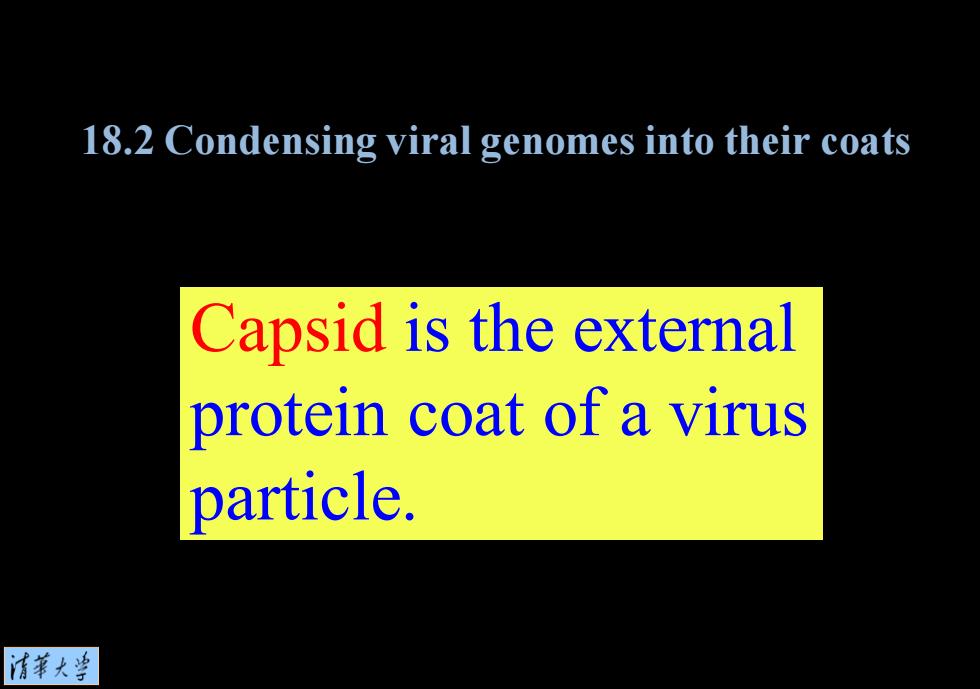
18.2 Condensing viral genomes into their coats Capsid is the external protein coat of a virus particle. 清菜大当
Capsid is the external protein coat of a virus particle. 18.2 Condensing viral genomes into their coats
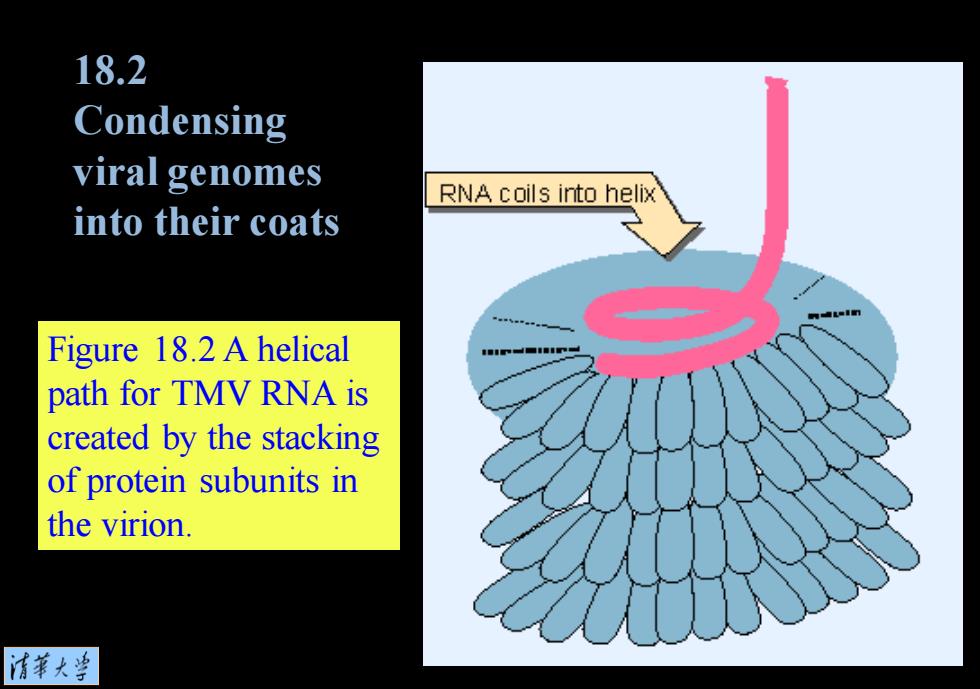
18.2 Condensing viral genomes RNA coils into helix into their coats Figure 18.2 A helical path for TMV RNA is created by the stacking of protein subunits in the virion. 情華大当
Figure 18.2 A helical path for TMV RNA is created by the stacking of protein subunits in the virion. 18.2 Condensing viral genomes into their coats
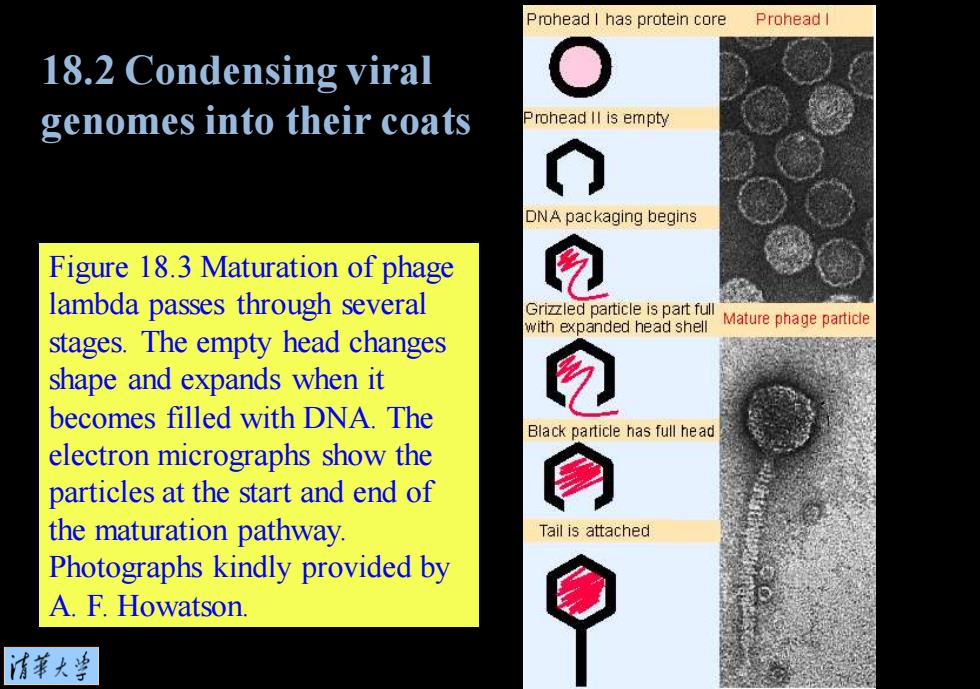
Prohead I has protein core Prohead I 18.2 Condensing viral genomes into their coats Prohead ll is empty DNA packaging begins Figure 18.3 Maturation of phage lambda passes through several Grizzled particle is part full with expanded head shell Mature phage particle stages.The empty head changes shape and expands when it becomes filled with DNA.The Black particle has full head electron micrographs show the particles at the start and end of the maturation pathway. Tail is attached Photographs kindly provided by A.F.Howatson. 清苇大当
Figure 18.3 Maturation of phage lambda passes through several stages. The empty head changes shape and expands when it becomes filled with DNA. The electron micrographs show the particles at the start and end of the maturation pathway. Photographs kindly provided by A. F. Howatson. 18.2 Condensing viral genomes into their coats

18.3 The bacterial genome is a nucleoid with many supercoiled loops Domain of a chromosome may refer either to a discrete structural entity defined as a region within which supercoiling is independent of other domains; or to an extensive region including an expressed gene that has heightened sensitivity to degradation by the enzyme DNAase I. Nucleoid is the compact body that contains the genome in a bacterium. 清菜大学
Domain of a chromosome may refer either to a discrete structural entity defined as a region within which supercoiling is independent of other domains; or to an extensive region including an expressed gene that has heightened sensitivity to degradation by the enzyme DNAase I. Nucleoid is the compact body that contains the genome in a bacterium. 18.3 The bacterial genome is a nucleoid with many supercoiled loops
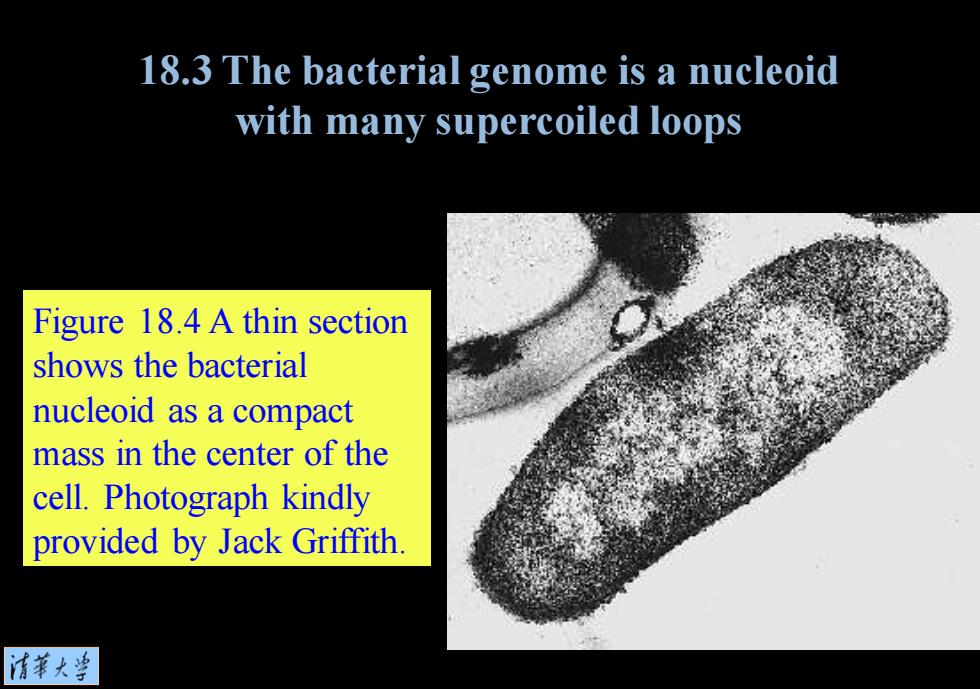
18.3 The bacterial genome is a nucleoid with many supercoiled loops Figure 18.4 A thin section shows the bacterial nucleoid as a compact mass in the center of the cell.Photograph kindly provided by Jack Griffth. 清苇大当
Figure 18.4 A thin section shows the bacterial nucleoid as a compact mass in the center of the cell. Photograph kindly provided by Jack Griffith. 18.3 The bacterial genome is a nucleoid with many supercoiled loops
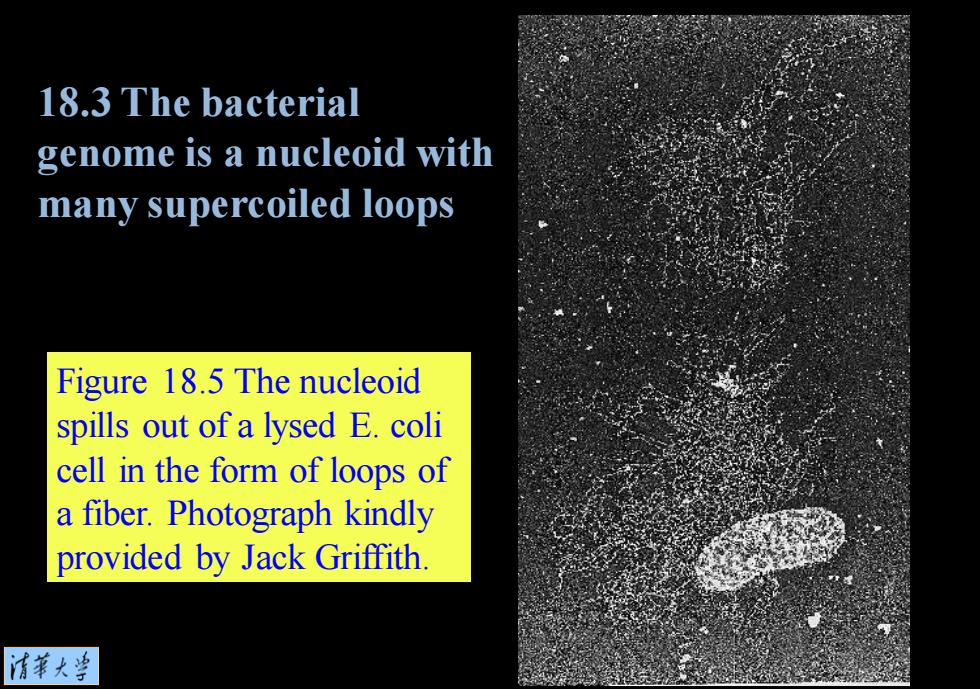
18.3 The bacterial genome is a nucleoid with many supercoiled loops Figure 18.5 The nucleoid spills out of a lysed E.coli cell in the form of loops of a fiber.Photograph kindly provided by Jack Griffith. 情華大当
Figure 18.5 The nucleoid spills out of a lysed E. coli cell in the form of loops of a fiber. Photograph kindly provided by Jack Griffith. 18.3 The bacterial genome is a nucleoid with many supercoiled loops